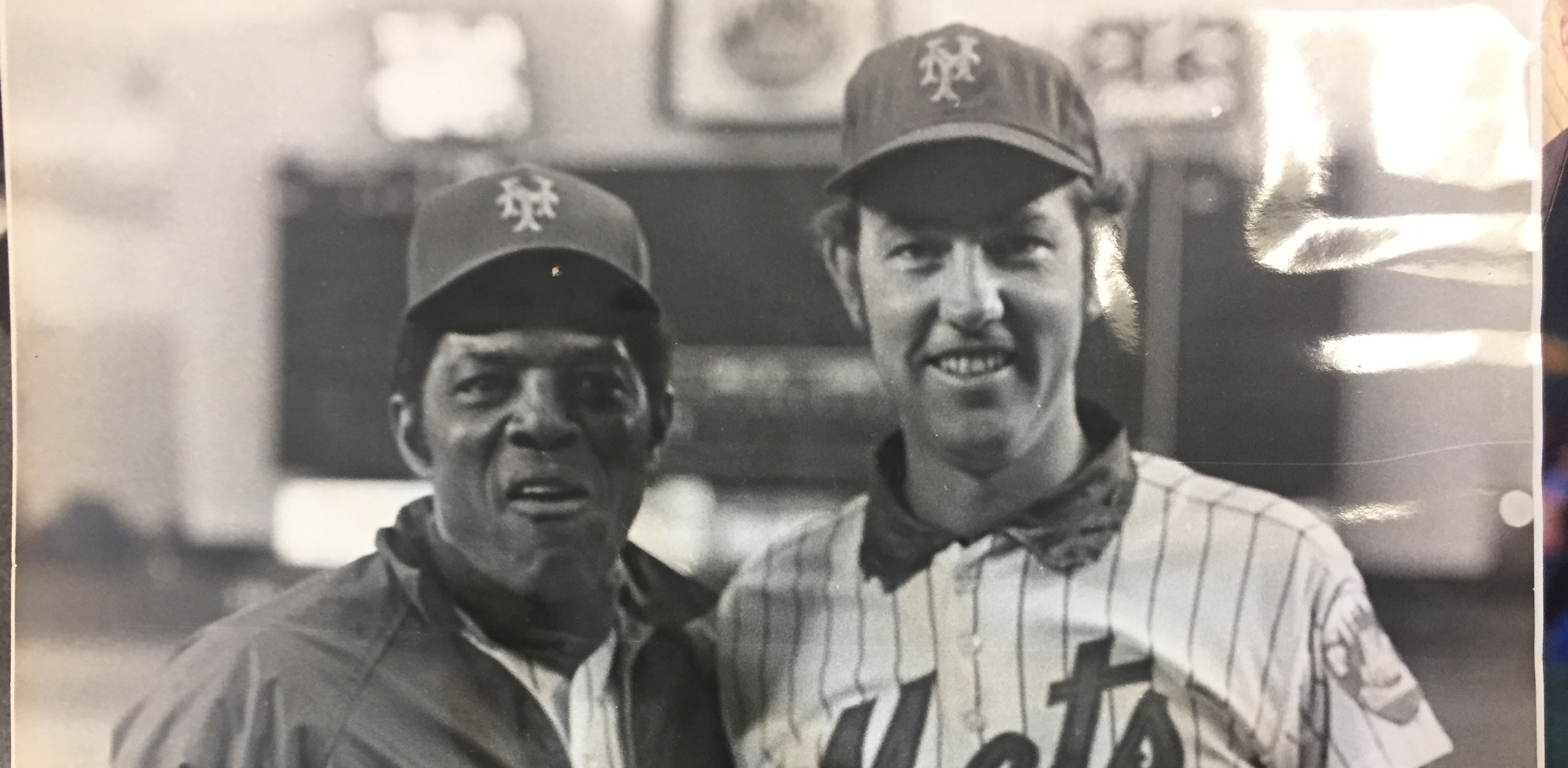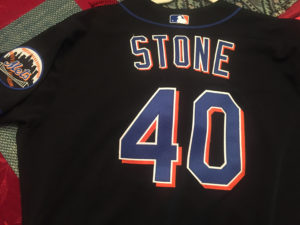By TEDDY ALLEN/Designated Writer
Former Ruston High and Louisiana Tech star pitcher George Stone, who will be inducted to the Ark-La-Tex Sports Museum of Champions in August, will forever be the focus of one of baseball’s Classic Second Guesses.
But first…
His New York Mets trailed the defending world champion Oakland A’s 5-1 in Game 7 of the 1973 World Series when George Stone relieved in the top of the seventh and pitched a pair of scoreless innings.
His effort did not prevent a loss — the Mets scored just one earned run that day and lost 5-2 — but it did keep the A’s from extending their lead, and the North Louisiana native his friends call “Stoney” did it with an exclamation point: in the 7th, with runners on first and second, he struck out the side — Joe Rudi, Sal Bando and Reggie Jackson, Oakland’s No. 2-4 hitters.
(This was after Rollie Fingers had reached on a bloop to right — yes, Fingers, the Hall of Fame reliever, led off the seventh, and yes, baseball has changed — and on the next batter, Bert Campaneris, first baseman John Milner could not get a fielded bunt out of his glove. First and second, nobody out.)
In the top of the 8th Stone got a flyball and two groundouts, his final appearance in a World Series.
(Go to youtube and watch it some time. It’s beautiful. The uniforms. How quickly they played the game. The announcers — Tony Kubek: “If he (Stone facing Jackson) gets out of this he’s done a whale of a job after Milner hurt him a little bit by not getting at least one out on the Campaneris bunt…”)
The Mets scored one unearned run in the top of the ninth and lost the game and a Series they’d led 3-game-to-2 when they’d left New York for Oakland.
Stone had just finished his finest major-league regular season, a 12-3 record as a regular in the Mets’ rotation. 2.65 ERA. A league-best winning percentage of .800. His eight straight wins down the stretch helped the Mets come from 12-and-a-half games back to win the National League East.
Then New York beat Cincinnati’s Big Red Machine in the NL Championship Series. Stone had a no-decision as a starter in one of the wins.
But in the Series, Mets manager Yogi Berra had Stone in the bullpen.
The debate always will be whether Berra should have started Stone in Game 6 of the Series, then have future Hall-of-Famer Tom Seaver on full rest and, if needed, No. 2 starter Jon Matlack and everyone else but “Stoney” to come out of the bullpen for a must-win Game 7.
Instead, Yogi started Seaver in Game 6 and Matlack in Game 7, both on short rest. Oakland’s duo of Catfish Hunter and Ken Holtzman beat Seaver and Matlack as the Mets scored just three runs in the two games, and the A’s had their second of three consecutive World Series titles.
“I thought I’d have a good shot at starting…I should have,” Stone said, more than 40 years removed from that October day. “I was the hot pitcher down the stretch. I was the kind of pitcher who gave a team like Oakland trouble.”
The A’s were free swingers, for sure. Stoney was control. Finesse. Patience.
And remember, the Mets didn’t have to win Game 6. They had a 3-2 lead. If the A’s beat Stone, the Mets have Seaver and Matlack and Staff for the must-win Game 7.
Stone didn’t know it until after the fact, but several Mets — Rusty Staub, Ed Kranepook, Cleon Jones — went to Berra and pleaded for Stone to start. But more likely than not, Seaver pleaded for the start too. And probably, so did the front office.
It’s New York, after all. And if Seaver wins, maybe he’s the Series MVP.
Except Seaver didn’t win. The Mets lost, 3-1.
Should Stoney have started? In hindsight, sure. Would it have made a difference? Who knows. It’s a classic “second guess” baseball story, and always will be.
Something with a lot less gray area are Stone’s credentials for induction into the Ark-La-Tex Museum of Champions as part of its Class of 2018. No debate about that.
Stone began elementary school in Doyline but moved with this family to Ruston halfway through his sixth-grade year; Ruston has been his home since.
He was a two-sport star in Lincoln Parish — first at Ruston High, where he was All-State in baseball as a junior and senior and All-State in basketball as a senior — then at Louisiana Tech, where he was All-Gulf States Conference as a freshman and sophomore in baseball and the basketball team’s second-leading scorer in his 1965-66 sophomore season.
But athletically, the future for the 6-foot-3, 205-pound lefthander was in baseball. More than 50 years have flown by and Stone remains prominent in the Tech record book:
- Fewest hits allowed in a season: first with 23
- Career ERA: 1.49, second;
- Season ERA: 1.02, fifth;
- Strikeouts per nine innings: 11.41, fourth;
- Fewest hits per nine innings: 5.04, fourth;
- Pitched a no-hitter as a sophomore.
After being a Little League, American Legion and semipro summer ball star, Stone started building his professional resume after his sophomore year at Tech when Atlanta selected him in the sixth round of the 1966 Major League Baseball draft:
- Eight full seasons, 1968-75, in the big leagues;
- In addition to Seaver and Berra (his Mets manager), Stone played with other Hall of Famers — Hank Aaron, Willie Mays, Phil Niekro, Orlando Cepeda, Joe Torre and Hoyt Wilhelm.
- Pitched in 203 big-league games, started 145, and had 21 complete games and five shutouts.
- Postseason numbers: four appearances, 10 2/3 innings, 1.69 ERA, seven strikeouts, one save (Game 2, ’73 Series.) As a Brave, he pitched in relief in the 1969 National League Championship Series against the Mets.
(One of his Braves’ teammates early in his career was Cecil Upshaw, his cousin and fellow pitcher — often as his reliever — who went from basketball and baseball at Bossier High School and Centenary College to the big leagues.)
A rotator cuff tear in 1974 interrupted Stone’s career. After a long rehab, he recovered enough to return and complete the 1975 season with the Mets, was traded to the Texas Rangers in February 1976, but with his shoulder problems retired before that season.
His MLB career record: 60-57, 590 strikeouts, 3.89 ERA. A hitting star in high school, he was no easy out in the majors: He hit .212 with 72 hits, a home run, four doubles and 39 RBI.
A pair of those eight big-league seasons were pure magic for Stone. He was 13-10 in 1969 when the Braves won the National League West Division (in the first year of divisional play). After an off-season trade to the Mets following the 1972 season, he won his final eight decisions in 1973 as New York came from 12 1/2 games behind to win the NL East.
The Mets beat Cincinnati in the National League Championship Series — Stone started Game 4 but didn’t get the decision — before losing to Oakland in the Series.
His friends who grew up playing ball with or against him or watching him play knew he had major league talent.
“He just had that look about him,” retired sportswriter and Tech graduate Nico Van Thyn said. “And he made it (to the majors) before baseball’s second expansion, when talent wasn’t as diluted. It was much tougher to make it to The Show in those days.”
“He was good enough to win without having to strike everybody on the team out,” said Randy Fallin, Stone’s teammate and left fielder at Tech and earlier an American Legion opponent. “He had great control, and he didn’t get rattled. I don’t think when we played them and George pitched that he even knew we were there.”
“He was easy to catch because he knew what he was doing, all the time,” said Curtis Barham, Stoney’s catcher from summertime pickup games through college. “Control and location were his best assets. And focus when performing. … He could feel the smallest thing wrong, and he would work until he got it fixed.”
“He was patient,” said Dianna Sumlin Stone, a Lincoln Parish schoolteacher when the couple married in winter before the 1972 baseball season and today the parish’s Registrar of Voters. “He studied his opponents. He knew what their weaknesses were; that’s what he pitched to.”
Behind the poker face, he had another secret weapon.
“I guess I changed personalities, really, when I was on the mound,” Stone said. “I’m a laid-back guy, but on the mound, something happened. For some reason, I’d step up there and things would just change for me.
“Like in basketball, with the ball in my hands, I didn’t think anybody could keep me from scoring. If you don’t have that, if nothing changes when you get on the mound, I don’t know if you can be successful. You’ve got to have a certain amount of competitiveness.”
Stone was a teacher and coach for 28 seasons and has been a substitute teacher in more recent years. Otherwise, he is hunting deer, fishing, cutting grass, preparing a Sunday school lesson, or playing with his grandchildren — four boys and one girl from his two daughters, Lauren and Suzanna. He also has two Pomeranians: “they love me,” he said.
He has a lot of friends who feel the same about him.
On top of that, now he also has his name in the Ark-La-Tex Museum of Champions.
-30-

